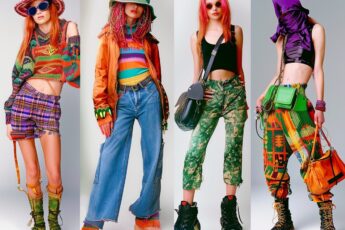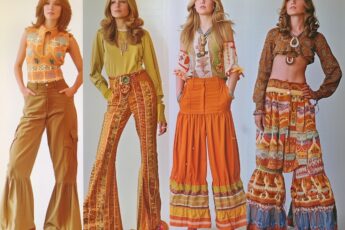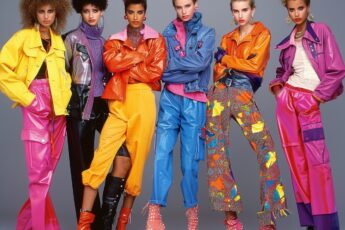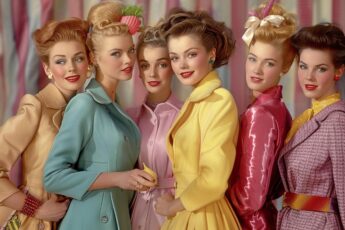Decoding 1920s Fashion
The 1920s transformed fashion forever. I’ve spent years studying this pivotal decade, and it never fails to captivate me. It was a time of rebellion, freedom, and unparalleled creativity in clothing.
When we think of the Roaring Twenties, images of flappers in short dresses and long beads immediately come to mind. But the era’s fashion revolution went far beyond these iconic looks. It reshaped how people dressed, thought about clothing, and expressed themselves through style.
The decade kicked off with a dramatic shift. Women shed their corsets and embraced looser, more comfortable silhouettes. Hemlines rose, shocking conservatives but delighting young rebels. Men’s fashion wasn’t left behind – suits became more relaxed, and sporty styles gained popularity.
Here’s a quick snapshot of key 1920s fashion elements:
- Flapper dresses
- Cloche hats
- Oxford bags (wide-leg trousers)
- T-strap shoes
- Art Deco jewelry
This era saw the birth of modern fashion as we know it. Designers like Coco Chanel revolutionized women’s wear, while Hollywood glamour influenced evening styles. Sportswear emerged as a new category, reflecting changing lifestyles and attitudes.
The 1920s weren’t just about clothes – they were about a whole new way of life. Fashion reflected and drove social change, from women’s liberation to the rise of youth culture.
Fashion is not something that exists in dresses only. Fashion is in the sky, in the street, fashion has to do with ideas, the way we live, what is happening.
As we delve into the chapters ahead, we’ll explore every facet of 1920s fashion. From the iconic looks to the social forces behind them, I’ll guide you through this fascinating decade that shaped the century to come.
Get ready to journey back to an era of bobbed hair, jazz rhythms, and style revolution. The 1920s await, and they have quite a story to tell.
The Flapper Look
The flapper embodied the spirit of the 1920s. Bold, daring, and unapologetically modern, she challenged societal norms through her appearance and behavior. I’ve always been fascinated by how this iconic look came to define an era.
Flappers wore short dresses that allowed for easy movement. They ditched corsets in favor of boyish figures. Their style was all about freedom and rebellion. Key elements of the flapper look included:
- Knee-length dresses
- Dropped waistlines
- Beaded or fringed embellishments
- Bobbed hair
- Heavy makeup
These young women smoked in public, danced the Charleston, and embraced a new sense of sexual freedom. Their fashion choices reflected this bold attitude.
Fashion is the armor to survive the reality of everyday life.
The flapper dress wasn’t just stylish – it was revolutionary. It allowed women to move freely, dance wildly, and express themselves like never before. I’ve seen how this look continues to inspire designers and fashion lovers today.
Changing Silhouettes
The 1920s saw a dramatic shift in silhouettes. Gone were the curves and corsets of the previous era. In their place came straight lines and boyish figures.
This change wasn’t subtle. It completely transformed how women dressed and moved. I find it remarkable how quickly this new silhouette took hold.
Key features of 1920s silhouettes:
- Drop-waist dresses: Waistlines fell to the hips, creating a long, lean look.
- Straight lines: Dresses hung straight from shoulder to hem.
- Flat chests: The ideal figure was boyish, with little emphasis on curves.
- Short hemlines: Skirts rose to just below the knee, scandalous for the time.
Here’s a comparison of silhouettes:
| 1910s | 1920s |
|---|---|
| Hourglass figure | Straight, boyish figure |
| Nipped waist | Dropped waist |
| Ankle-length skirts | Knee-length skirts |
| Emphasize bust and hips | De-emphasize curves |
This new silhouette reflected changing attitudes about women’s roles in society. It allowed for more movement and comfort, so women could finally breathe easily and move freely in their clothes.
Fashions fade, style is eternal.
The straight silhouette of the 1920s laid the groundwork for modern fashion. It challenged the idea that women needed to conform to a single ideal body shape, and this principle continues to influence designers and fashion lovers today.
Hemlines and Scandal
The rising hemlines of the 1920s caused quite a stir. I’ve always found it fascinating how a few inches of fabric could spark such controversy. As skirts crept up from ankles to knees, society’s reaction ranged from shock to celebration.
This hemline revolution happened gradually:
- 1910s: Ankles peeked out
- Early 1920s: Calves became visible
- Mid-1920s: Knees emerged
- Late 1920s: Hemlines reached their peak, just below the knee
The shorter skirts symbolized women’s growing freedom. They allowed for easier movement and participation in sports. But not everyone approved. Conservatives viewed the new styles as immoral and dangerous.
Fashion is the most powerful art there is. It’s movement, design, and architecture all in one. It shows the world who we are and who we’d like to be.
Despite the outcry, women embraced their new freedom. The rising hemlines reflected broader social changes:
- Women’s suffrage movement
- Increased presence in the workplace
- Growing economic independence
This table shows the impact of hemlines on women’s daily lives:
| Activity | Before | After |
|---|---|---|
| Dancing | Restricted | Energetic |
| Sports | Limited | Active participation |
| Work | Impractical | More comfortable |
The hemline revolution of the 1920s did more than change fashion. It challenged social norms and contributed to women’s liberation. Even today, I see its influence on how we view fashion as a form of personal expression and freedom.
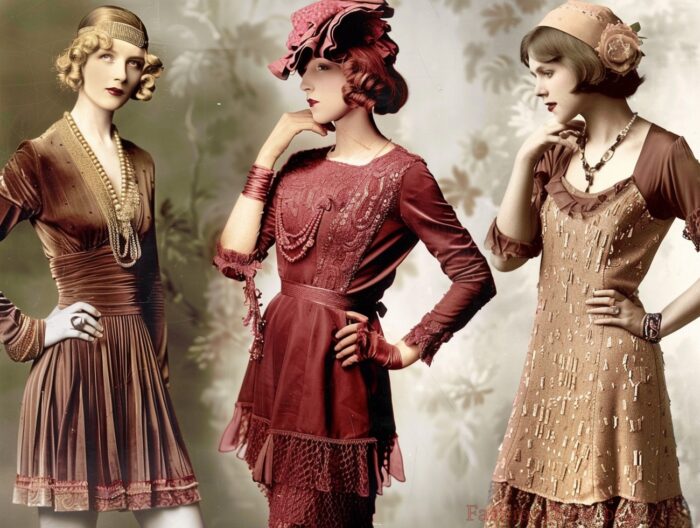
Accessories of the Era
1920s accessories played a crucial role in completing the iconic looks of the decade. I’ve always admired how these elements added flair and personality to the streamlined silhouettes of the era.
Key accessories included:
- Cloche hats: These close-fitting, bell-shaped hats became a symbol of the era.
- Long necklaces: Strings of pearls or beads often reached the waist.
- Headbands: Often adorned with feathers or jewels for evening wear.
- Art Deco jewelry: Geometric shapes and bold colors reflected the artistic movement.
- Small clutch purses: Perfect for carrying compact mirrors and cigarette cases.
The influence of Art Deco on 1920s accessories can’t be overstated. This artistic movement brought bold geometric designs and vibrant colors to jewelry and other decorative items.
Accessories are what, in my opinion, pull the whole look together and make it unique.
Here’s how accessories transformed different looks:
| Outfit | Accessory | Effect |
|---|---|---|
| Day dress | Cloche hat | Chic and modern |
| Evening gown | Long pearl necklace | Elegant and sophisticated |
| Casual wear | Colorful scarf | Playful and trendy |
Accessories allowed women to express their individuality within the somewhat uniform styles of the decade. With the right combination of jewelry, hats, and other adornments, they could transform a simple dress into a unique outfit.
The creativity and boldness of 1920s accessories continue to inspire designers today. I often see elements of this era in contemporary fashion, from geometric patterns in jewelry to the enduring popularity of long necklaces.
Footwear Revolution
The 1920s brought a footwear revolution that perfectly complemented the era’s fashion trends. I find the shoe styles of this decade particularly exciting because they reflect the newfound freedom and playfulness in women’s fashion.
Three key shoe styles defined the era:
- T-strap shoes: These elegant shoes featured a strap across the instep, forming a “T” shape.
- Mary Janes: This classic style has a single strap across the foot and is popular for both day and evening wear.
- Oxford shoes: Originally men’s shoes, women adopted this lace-up style for a sporty, masculine look.
These shoes shared some common characteristics:
- Low, chunky heels for easier dancing
- Ankle-baring designs to show off stockings
- Decorative elements like buckles, bows, or beading
Give a girl the right shoes, and she can conquer the world.
The footwear of the 1920s allowed women to dance, walk, and move with unprecedented ease. Here’s how different shoe styles suited various activities:
| Activity | Shoe Style | Benefits |
|---|---|---|
| Dancing | T-strap | Secure fit, decorative |
| Work | Oxfords | Comfortable, practical |
| Evening | Mary Janes | Elegant, versatile |
I’ve noticed that many contemporary shoe designs draw inspiration from these 1920s classics. The era’s focus on both style and comfort continues to influence footwear fashion today.
Makeup and Beauty Standards
The 1920s ushered in a new era of makeup and beauty standards that broke with traditional notions of femininity. I find this shift fascinating because it represents a broader change in women’s roles and self-expression.
Key elements of 1920s makeup included:
- Dark, smoky eyes
- Thin, arched eyebrows
- Deep red lipstick
- Pale, powdered skin
This dramatic look contrasted sharply with the natural, minimal makeup of previous decades. Women now used cosmetics boldly and publicly, challenging social norms.
Hairstyles also underwent a radical transformation. The bob became the defining hairstyle of the era. This short, chin-length cut symbolized independence and modernity. Variations included:
- The shingle: Very short, tapered at the nape
- The Eton crop: An even shorter, boyish style
- The Marcel wave: A wavy style created with heated irons
The most beautiful makeup of a woman is passion. But cosmetics are easier to buy.
The beauty industry boomed during this period. New products and techniques emerged to help women achieve these looks:
| Product | Purpose |
|---|---|
| Kohl eyeliner | Create dramatic eyes |
| Rouge | Add color to cheeks |
| Powder | Achieve a pale complexion |
| Hair pomade | Style short cuts |
These beauty trends reflected changing ideals of feminine beauty. The soft, delicate look of the Victorian era gave way to a bolder, more confident aesthetic. I see echoes of this transformation in today’s beauty trends, where self-expression and individuality often take center stage.
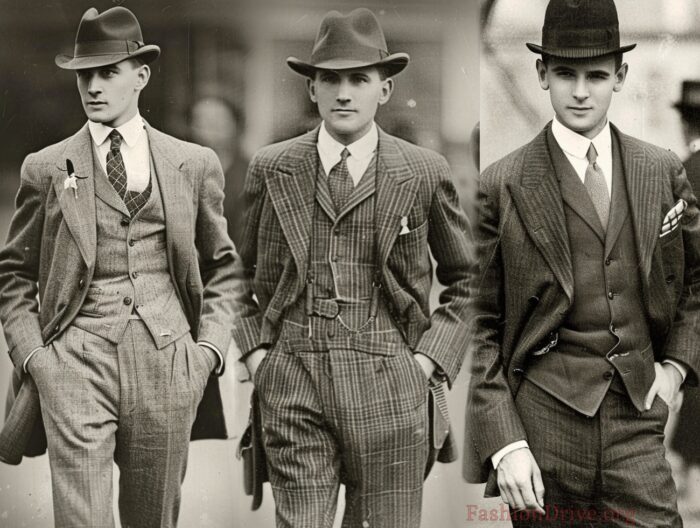
Men’s Fashion in the Roaring Twenties
The 1920s revolutionized men’s fashion as much as women’s. I find this era particularly interesting for its blend of traditional tailoring and new, relaxed styles. Men’s clothing evolved to reflect the decade’s spirit of change and modernity.
Key elements of 1920s men’s fashion included:
- Suits: Looser fit, higher waists, wider lapels
- Oxford bags: Extremely wide-legged trousers
- Plus-fours: Knee-length baggy knickerbockers for sports
- Sweater vests: Often in bold, colorful patterns
- Fedoras and bowler hats: Essential accessories
The silhouette became slimmer and more athletic. Shoulders were less padded, and jackets featured a higher button stance. Colors grew bolder, moving away from the somber tones of previous decades.
Clothes make the man. Naked people have little or no influence on society.
Here’s how men’s fashion adapted to different occasions:
| Occasion | Attire | Features |
|---|---|---|
| Business | Suit | Three-piece, often pinstriped |
| Casual | Knickerbockers | Paired with patterned socks |
| Sports | Plus-fours | Worn with argyle sweaters |
| Evening | Tuxedo | Wider lapels, cummerbund |
The influence of sport on men’s fashion was significant. Golf and tennis-inspired comfortable, loose-fitting clothes that soon became popular for everyday wear. I see echoes of this trend in today’s athleisure movement.
Evening Wear and Glamour
Evening wear in the 1920s epitomized the era’s glamour and exuberance. I’m always struck by the sheer opulence of these designs, which reflected the decade’s economic prosperity and love of spectacle.
For women, key elements of 1920s evening wear included:
- Beaded and sequined gowns
- Dropped waists
- Bare arms and backs
- Tiaras and elaborate headpieces
- Feather boas and fans
Men’s evening wear also evolved, though more subtly. Tuxedos became softer and less rigid, with wider lapels and a more comfortable fit.
Hollywood’s profound influence on evening fashion was evident. Stars like Clara Bow and Rudolph Valentino set trends that millions eagerly followed.
Fashion is what you’re offered four times a year by designers. And style is what you choose.
Designer fashion shows gained prominence during this era, becoming spectacular events in their own right. These shows helped popularize new styles and cemented the role of designers as tastemakers.
Here’s how evening wear changed over the decade:
| Early 1920s | Late 1920s |
|---|---|
| Ankle-length gowns | Knee-length dresses |
| Subtle embellishments | Lavish beading and sequins |
| Modest necklines | Plunging backs |
| Soft colors | Bold, vibrant hues |
The evening wear of the 1920s continues to inspire designers today. I often see modern red carpet looks that echo the glamour and daring of this unforgettable era. The decade’s fusion of luxury and liberation created a style that remains timeless.
Sportswear and Casual Attire
The 1920s saw the birth of modern sportswear and casual clothing. This shift revolutionized how people dressed for leisure activities. I find this development particularly significant because it laid the groundwork for much of today’s everyday fashion.
Key elements of 1920s sportswear included:
- Tennis whites: Crisp, all-white outfits for both men and women
- Knit sweaters: Often in bold patterns or school colors
- Beach pajamas: Wide-legged jumpsuits for seaside lounging
- Shorts: Primarily for men, but women began wearing them for sports
- Swimwear: Less restrictive styles that allowed for actual swimming
The rise of sportswear reflected changing social attitudes. People now valued comfort and practicality in their clothing. This shift aligned with the decade’s emphasis on youthfulness and activity.
Style is a way to say who you are without having to speak.
Here’s how sportswear influenced different activities:
| Activity | Clothing Item | Impact |
|---|---|---|
| Tennis | White pleated skirts | Allowed for freer movement |
| Golf | Plus-fours | Became fashionable off the course |
| Swimming | One-piece suits | Enabled women to swim properly |
| Skiing | Knit sweaters | Provided warmth and style |
The popularity of these clothes extended beyond sports. People began wearing sweaters and comfortable trousers for everyday activities. I see this as the beginning of the casual wear trend that dominates fashion today.
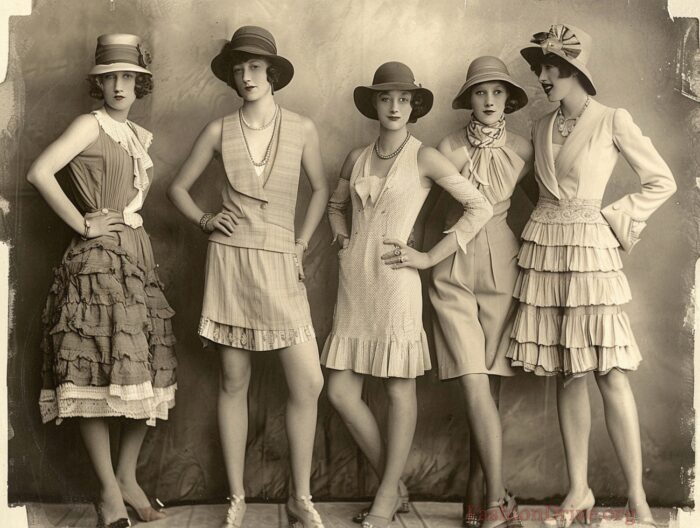
Textile Innovations
The 1920s brought significant textile innovations that shaped the look and feel of fashion. These new fabrics and manufacturing techniques enabled the creation of the decade’s iconic styles. I find this aspect of 1920s fashion particularly fascinating because it shows how technology and design intersect.
Key textile developments included:
- Artificial silks: Rayon became popular as a cheaper alternative to silk
- Jersey knits: Coco Chanel popularized this comfortable, stretchy fabric
- Cotton and wool blends: Offered durability and easy care
- Printed fabrics: New techniques allowed for bold, colorful patterns
These innovations allowed for the mass production of fashionable clothes, making trendy styles more accessible to the general public.
Fashion is not necessarily about labels. It’s not about brands. It’s about something else that comes from within you.
The Art Deco movement heavily influenced textile designs of the era. Geometric patterns and bold color combinations became hugely popular. Here’s how different fabrics were used:
| Fabric | Common Use | Characteristics |
|---|---|---|
| Rayon | Dresses, lingerie | Silky feel, affordable |
| Jersey | Sportswear, dresses | Stretchy, comfortable |
| Wool blends | Suits, coats | Durable, warm |
| Printed cotton | Day dresses | Colorful, washable |
These textile innovations had lasting effects on the fashion industry. They paved the way for the development of synthetic fabrics and new manufacturing techniques. I see their influence in the wide variety of fabrics and finishes available to designers today.
Influential Designers
The 1920s saw the rise of fashion designers who shaped the decade’s iconic looks. Their innovative designs and bold ideas transformed the industry. I find their work particularly compelling because it reflects the era’s spirit of rebellion and creativity.
Three designers stood out for their revolutionary approaches:
- Coco Chanel: Pioneered comfortable, practical women’s wear
- Jean Patou: Popularized sportswear and the cardigan sweater
- Elsa Schiaparelli: Brought surrealist elements into fashion
Chanel’s influence was particularly profound. She introduced:
- The little black dress
- Costume jewelry
- Women’s trousers for everyday wear
Patou made his mark with:
- Monogrammed sportswear
- The tennis skirt
- Sleeveless sweaters
Schiaparelli pushed boundaries with:
- Unusual buttons and fastenings
- Surrealist-inspired prints
- The wrap dress
Fashion fades, only style remains the same.
Here’s how these designers influenced different aspects of 1920s fashion:
| Designer | Innovation | Impact |
|---|---|---|
| Chanel | Jersey fabric | Made comfortable clothing fashionable |
| Patou | Sportswear | Blurred lines between athletic and everyday wear |
| Schiaparelli | Artistic designs | Brought high art into fashion |
These designers’ work went beyond creating clothes. They challenged social norms and redefined femininity. Their influence extends to today’s fashion, where comfort, practicality, and artistic expression remain key elements.
Fashion and Social Change
Fashion in the 1920s both reflected and drove social change. The decade’s clothing styles were inseparable from the broader cultural shifts happening at the time. I find this interplay between fashion and society fascinating, as it demonstrates how what we wear can be a powerful form of expression and rebellion.
Key social changes influencing fashion included:
- Women’s suffrage movement
- Prohibition and speakeasy culture
- Changing workplace roles for women
- The rise of youth culture
These societal shifts manifested in fashion in various ways:
- Shorter hemlines symbolized women’s liberation
- Loose-fitting clothes allowed for freer movement, including dancing
- Practical daywear reflected women’s increasing presence in the workforce
- Bold, flashy styles appealed to the youth-oriented culture of the time
Fashion is the armor to survive the reality of everyday life.
The impact of these changes varied across different aspects of life:
| Sphere | Fashion Change | Social Implication |
|---|---|---|
| Politics | Suffragette white | Visual unity in protests |
| Nightlife | Beaded dresses | Glamour of speakeasy culture |
| Workplace | Tailored suits for women | Growing professional roles |
| Youth culture | College-inspired looks | Assertion of generational identity |
Fashion became a way for people, especially women, to express their changing roles and aspirations. The clothes of the 1920s weren’t simply about style – they were a declaration of independence and a reflection of a rapidly changing world. This connection between fashion and social movements continues to this day, reminding us of clothing’s power as a form of personal and political expression.
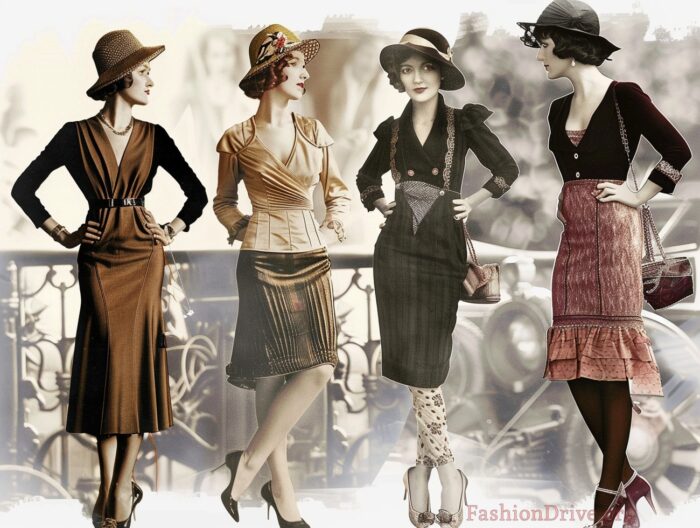
Global Influences on 1920s Fashion
The 1920s saw fashion becoming increasingly international, with influences from around the world shaping trends. I find this global exchange of styles particularly fascinating, as it set the stage for the interconnected fashion world we know today.
Three major global influences stood out:
- Egyptian Revival: The discovery of Tutankhamun’s tomb in 1922 sparked a craze for Egyptian-inspired designs.
- Oriental motifs: Chinese and Japanese aesthetics influenced everything from fabrics to accessories.
- Jazz culture: African American music and dance styles had a profound impact on fashion.
The Egyptian Revival brought:
- Geometric patterns in jewelry and textiles
- Snake motifs in accessories
- Rich, metallic colors
Oriental influences included:
- Kimono-style robes and wraps
- Chinese-inspired embroidery
- Jade and lacquer accessories
Jazz culture contributed:
- Looser, easier-to-dance-in clothing
- Bright, bold colors
- Fringe and beaded embellishments
Fashion is a language that creates itself in clothes to interpret reality.
Here’s how these global influences manifested in different aspects of 1920s fashion:
| Influence | Fashion Item | Characteristics |
|---|---|---|
| Egyptian | Art Deco jewelry | Geometric, bold designs |
| Oriental | Evening coats | Rich fabrics, elaborate embroidery |
| Jazz | Flapper dresses | Fringe, easy movement |
These global influences brought new vitality to 1920s fashion. They expanded the visual vocabulary of designers and wearers alike, creating a richer, more diverse fashion landscape. I see echoes of this international exchange in today’s global fashion industry, where cross-cultural influences continue to drive innovation and creativity.
Legacy of 1920s Fashion
The 1920s fashion left an enduring legacy that continues to influence style today. I’m constantly amazed by how elements from this era resurface in contemporary design, proving the timelessness of its innovation.
Key aspects of 1920s fashion that have had a lasting impact:
- The little black dress: Introduced by Coco Chanel, now a wardrobe staple
- Costume jewelry: Making glamorous accessories accessible to all
- Sportswear as everyday wear: The foundation of modern casual fashion
- Bob hairstyle: Periodically revived in various forms
- Art Deco influences: Still popular in jewelry and graphic design
The 1920s also changed how we think about fashion:
- It popularized the concept of “dressing for yourself” rather than for social conformity
- It linked fashion with youth culture, a connection that remains strong today
- It established the idea of seasonal fashion collections
What you wear is how you present yourself to the world, especially today, when human contacts are so quick. Fashion is instant language.
Here’s how some 1920s trends have been revived in recent decades:
| 1920s Trend | Modern Revival | Adaptation |
|---|---|---|
| Flapper dress | 1960s shift dress | Straighter silhouette |
| Cloche hat | 1990s bucket hat | More casual materials |
| Long necklaces | 2000s layered necklaces | Mixed materials and lengths |
| Art Deco prints | 2010s geometric patterns | Bold colors, digital prints |
The 1920s hold a unique place in fashion history. The era’s emphasis on freedom, self-expression, and modernity resonates with contemporary values. Designers today often look to the 1920s for inspiration, adapting its iconic styles for modern tastes.
This ongoing influence underscores the revolutionary nature of 1920s fashion and its continued relevance in shaping how we dress and express ourselves through clothing.
Conclusion
The 1920s fashion revolution transformed how we dress and think about clothing. This decade broke free from restrictive Victorian norms, embracing comfort, freedom, and self-expression. I’ve explored how these changes reflected broader social shifts and technological advancements.
Key takeaways from 1920s fashion include:
- The rise of the flapper look
- Changing silhouettes favoring straight lines
- New accessories like cloche hats and long necklaces
- Innovations in sportswear and casual attire
- Global influences shaping trends
The fashion industry as we know it today took shape in the 1920s. Designers became household names, seasonal collections emerged, and fashion shows gained prominence. These developments laid the groundwork for the modern fashion world.
Fashion is not something that exists in dresses only. Fashion is in the sky, in the street, fashion has to do with ideas, the way we live, what is happening.
The legacy of 1920s fashion endures. We see its influence in:
- The ongoing popularity of the little black dress
- The acceptance of comfortable, practical clothing for everyday wear
- The use of Art Deco motifs in design
- The blending of masculine and feminine elements in fashion
The 1920s proved that fashion can be a powerful tool for social change and personal expression. As we continue to navigate changing social norms and global influences, the innovative spirit of 1920s fashion remains a source of inspiration and guidance.
